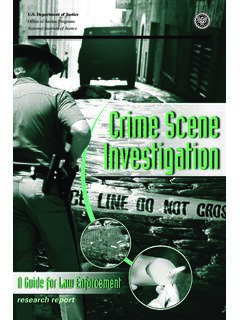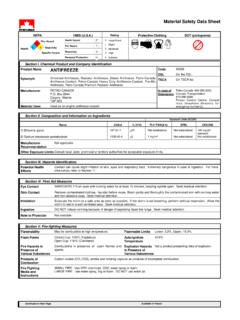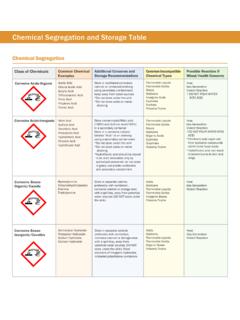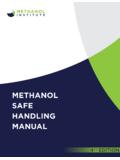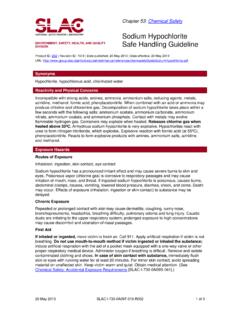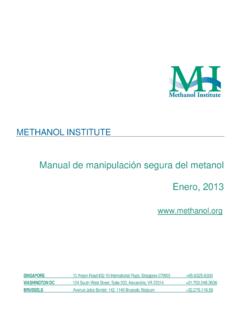Transcription of Processing Guide for Developing Latent Prints
1 Department of JusticeFederal Bureau of InvestigationLaboratory DivisionProcessing Guide forDeveloping Latent PrintsRevised 2000 Processing Guide for Developing Latent Prints (2000) Processing Guide for Developing Latent Prints (2000)Compiled by:Timothy A. TrozziFingerprint Specialist (Forensic Examiner)Federal Bureau of InvestigationRebecca L. SchwartzResearch ChemistFederal Bureau of InvestigationMitchell L. HollarsFingerprint Specialist (Forensic Examiner)Federal Bureau of InvestigationEdited by:Lallie D. LeightonSally A. SchehlYvette E. TrozziColleen WadeQuestions concerning the Processing Guide for Developing Latent Prints may be directed to:Laboratory DivisionLatent print Unit 2501 Investigation ParkwayQuantico, Virginia 22153(703) 632-8443 FAX (703) 632-7397 Processing Guide for Developing Latent Prints (2000)Table of ContentsTable of ContentsIntroduction.
2 1 Safety ..2 Laboratory Chemicals and Equipment ..2 Weights, Measures, and Temperature ..3 Processing Procedures and Sequences ..4 Standard ProcessesAdhesive Surface TechniquesAlternate Black Powder .. 10 Ash Gray Powder .. 11 Gentian Violet ..12 Sticky-Side Powder .. 13 Amido Black (Methanol Base) ..14 Amido Black (Water Base Fischer 98) .. 16 Cyanoacrylate Fuming (Microburst Method) .. 18 Cyanoacrylate Fluorescent Dye (RAM) .. 19 DAB (Diaminobenzidine) .. 21 DFO (1,8-Diazafluoren-9-One) ..24 Fingerprint Powders .. 26 Iodine Fuming .. 28 Iodine Spray Reagent .. 29 LCV (Leucocrystal Violet) .. 31 Ninhydrin (Petroleum Ether Base) ..33 Physical Developer (PD).
3 34 Silver Nitrate .. 38 Sudan Black .. 40 Vacuum Metal Deposition (VMD) .. 41 Optional ProcessesAmido Black (Water Base) .. 43 Ardrox (Fluorescent Dye) .. 45 Coomassie Brilliant Blue .. 47 Crowle s Double Stain .. 49 Liqui-Drox .. 51 MBD (Fluorescent Dye) .. 52 MRM 10 (Fluorescent Dye) .. 54 Ninhydrin (Acetone Base) .. 56 Rhodamine 6G (Fluorescent Dye) .. 57 Safranin O (Fluorescent Dye) .. 59 Thenoyl Europium Chelate (Fluorescent Dye) .. 60 Tape Chart by Method ..62 Chemical Synonyms ..64 Processing Guide for Developing Latent Prints (2000)1 IntroductionThe identification of Latent print evidence is often key in solving a crime. A Latent print results from thereproduction of friction ridges found on parts of the fingers, hands, and feet.
4 These Prints consist of acombination of different chemicals that originate from natural secretions, blood, and contaminants. Naturalsecretions mainly derive from the eccrine and sebaceous glands and contain known chemicalcomponents. Eccrine gland secretions from the fingers, hands, and feet are both organic and inorganic,but only organic materials are secreted from the sebaceous glands. Other contaminants found in printsresult from contact with different materials in the environment. Latent Prints can be found on all types ofsurfaces. In general, surfaces can be characterized as porous, nonporous, or semiporous. Understandingthese characteristics will aid in Processing an item for Latent beginning of this manual is a list of processes and procedures for different surface types.
5 Alsoincluded are Processing sequences that specifically involve Prints that are left in blood. Following theselists are details for each process that is currently implemented in the Latent print Unit (LPU) of theFederal Bureau of Investigation (FBI) Guide for Developing Latent Prints (2000)2 SafetyThe reader is advised to follow safe work practices when handling the chemicals used in Latent printdevelopment. safe work practices include the use of personal protective equipment ( , gloves,laboratory coats, eye protection), engineering controls ( , ventilation hoods), and hygiene practices( , washing hands, no eating or drinking).The reader assumes the responsibility of obtaining the necessary knowledge concerning each chemicalused, the hazard(s) it may pose, and the procedures and work practices necessary to prevent unhealthfulexposure.
6 This information is available from the Material Safety Data Sheets (MSDS) and the labelsaffixed to the Federal Bureau of Investigation is not responsible for the actions of any personnel outside the FBIusing this Guide with regard to the handling , use, or improper disposal of the chemicals Chemicals and EquipmentThe following reagent grade chemicals are used commonly in the Latent print Processing techniquesdescribed in this manual:AcetoneEthanolEthyl acetateGlacial acetic acidIsopropyl alcoholMethanolPetroleum etherAcetonitrile is HPLC is a complete list of the laboratory equipment needed for the techniques described in this clear and dark storage bottles; squirt bottles or sprayerBrushes air, camel-hair, fiberglass filament, and other brushesCottonDishes aluminum, ceramic, and petri or other shallow dishesFeather dusterFilter paperFume hoodFuming chamberGlassware beakers and graduated cylinders of various sizes.
7 Glass dishes and traysHeat gunHeater or other heat sourceHumidity chamber or humidified environmentLaser or alternate light source, including ultraviolet lightMagna brush wandMagnetic stirrer and stirring rod or other stirring deviceOrbital shakerOvenPaper towelsPlastic bottles or containersProcessing Guide for Developing Latent Prints (2000)3 Refrigerator with freezerScalesSteam ironTissuesVacuum metal deposition chamberWeights, Measures, and Temperaturekiloliter .. kL1 kL = 1000 Lliter .. L1 L = 1000 mLmilliliter .. mL1 mL = Lkilogram .. kg1 kg = 1000 ggram .. g1 g = 1000 mgmilligram .. mg1 mg = ggallon .. gal1 gal = 4 qt = Lquart.
8 Qt1 qt = 2 pt = Lpint .. pt1 pt = mLatmosphere .. atm1 atm = 760 torr pounds per square inch (psi)teaspoon .. tspConverting from Fahrenheit ( F) to Celsius ( C)tC = 5/9 (tF - 32)Converting from Celsius ( C) to Fahrenheit ( F)tF = 9/5 tC + 32 Processing Guide for Developing Latent Prints (2000)4 Processes and ProceduresUsed to Develop Latent PrintsProper Sequences and Types of Processes for Porous,Nonporous, and Some Unique and/or Difficult SurfacesAdherence to correct Processing techniques increases the probability of Developing the best quality latentprints. Adherence to the listed sequences ensures the best opportunity to develop all Latent Prints on anobject and minimizes the chance of destroying Latent on which Latent Prints are deposited can be divided into two basic categories porous andnonporous.
9 Listed below are the suggested sequential processes for porous, nonporous, semiporous, andsome unique and/or difficult on the circumstances, all of the suggested processes will not always be performed. This is leftto the discretion of the Surfaces1. Visual2. Inherent fluorescence by laser or alternate light source*3. Iodine fuming4. DFO (1,8-Diazafluoren-9-one)5. Laser or alternate light source6. Ninhydrin7. Physical developer* Alternate light source includes ultraviolet (UV) lightNonporous Surfaces1. Visual2. Inherent fluorescence by laser or alternate light source3. Cyanoacrylate fuming4. Laser or alternate light source5. Cyanoacrylate dye6.
10 Laser or alternate light source7. Vacuum metal deposition (VMD) Processing Guide for Developing Latent Prints (2000)58. PowderBloodstained Specimens Porous1. Visual2. Inherent fluorescence by laser or alternate light source3. DFO (1,8-Diazafluoren-9-one)4. Laser or alternate light source5. Ninhydrin6. Diaminobenzidine (DAB); if not available, use amido black7. Physical developerBloodstained Specimens Nonporous1. Visual2. Inherent fluorescence by laser or alternate light source3. Diaminobenzidine (DAB); if not available, use leucocrystal violet (LCV) or amido black4. Cyanoacrylate fuming5. Laser or alternate light source6. Cyanoacrylate dye7.
